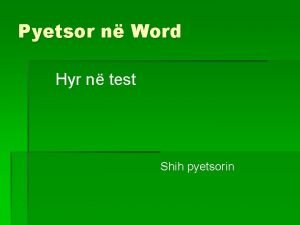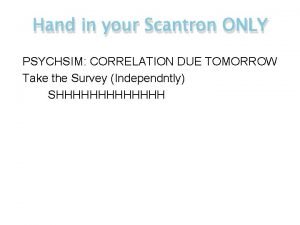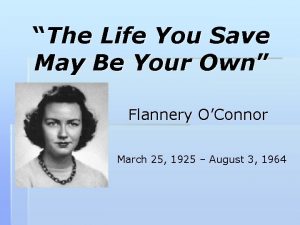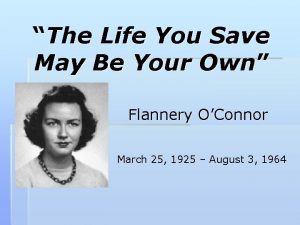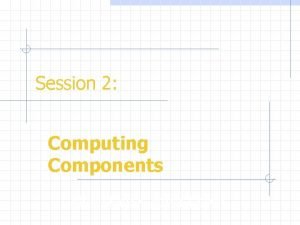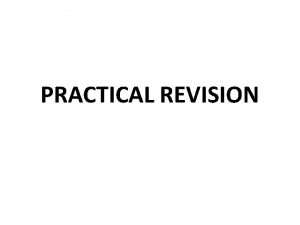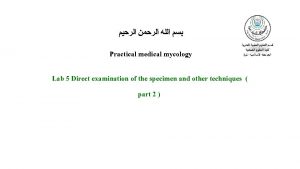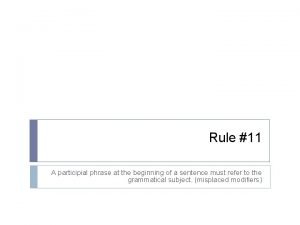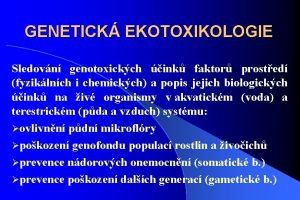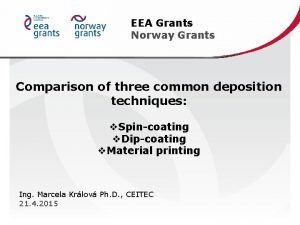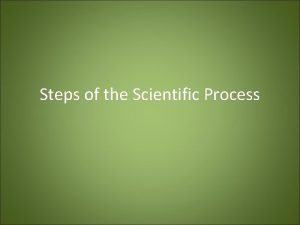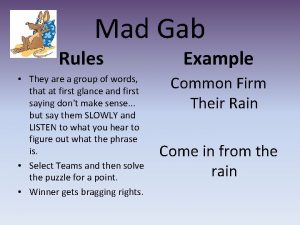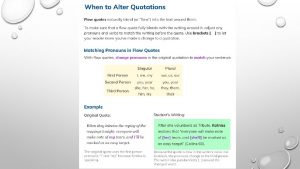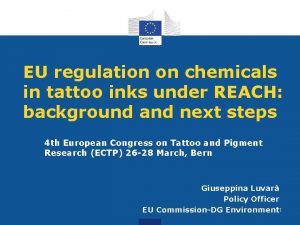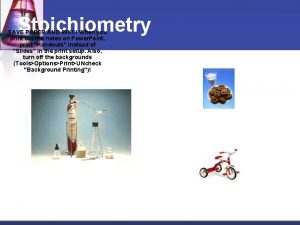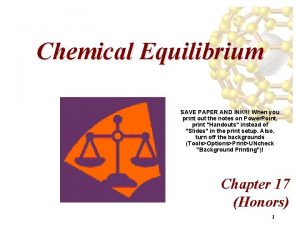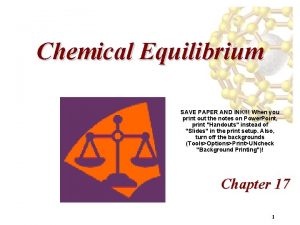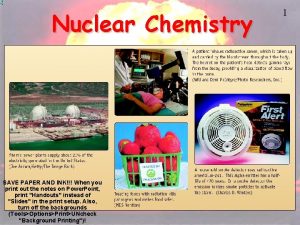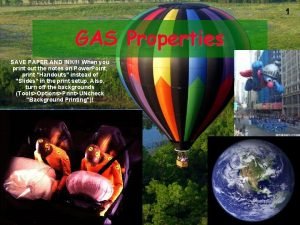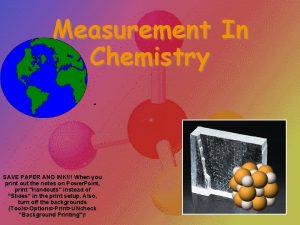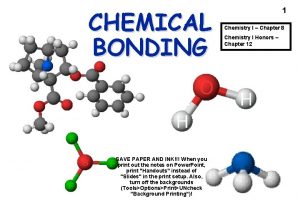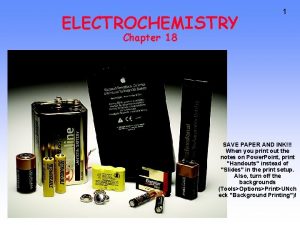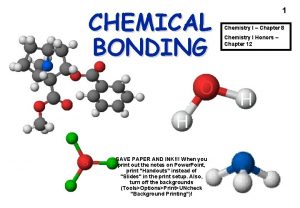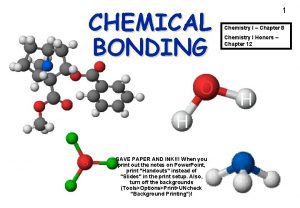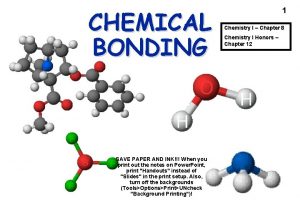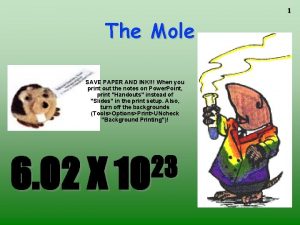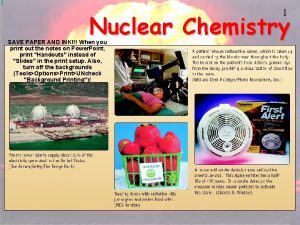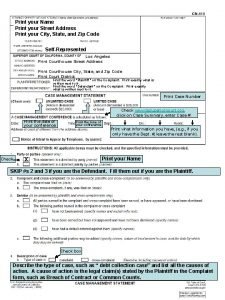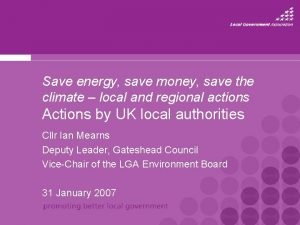GASES SAVE PAPER AND INK When you print



















































- Slides: 51

GASES SAVE PAPER AND INK!!! When you print out the notes on Power. Point, print "Handouts" instead of "Slides" in the print setup. Also, turn off the backgrounds (Tools>Options>Print>UNcheck "Background Printing")!

THREE STATES OF MATTER

Kinetic Molecular Theory Gases consist of tiny particles Gas particles are in constant motion Volume can be zero There are no attractive forces between particles/ no collisions • KE is directly proportional to Kelvin temperature. • •

General Properties of Gases • Low Density - There is a lot of “free” space in a gas. • Expansion. Gases fill containers uniformly and completely. • Diffusion - Gases spread out and mix rapidly. • Fluidity – molecules slide past each other • Compressibility – molecules can be pushed closer to each other.

Deviations from Ideal Gas Law • Real molecules have volume. The ideal gas consumes the entire amount of available volume. It does not account for the volume of the molecules themselves. • There are intermolecular forces. An ideal gas assumes there are no attractions between molecules. Attractions slow down the molecules and reduce the amount of collisions. – Otherwise a gas could not condense to become a liquid.

Pressure of air is measured with a BAROMETER (developed by Torricelli in 1643) Hg rises in tube until force of Hg (down) balances the force of atmosphere (pushing up). (Just like a straw in a soft drink) P of Hg pushing down related to • Hg density • column height

Pressure Column height measures Pressure of atmosphere • 1 standard atmosphere (atm) * = 761. 84 mm Hg (or torr) * = 29. 92 inches Hg * = 14. 7 pounds/in 2 (psi) = 101. 3 k. Pa (SI unit is PASCAL) = about 34 feet of water! * Memorize these!

STP in chemistry stands for Standard Temperature and Pressure STP allows us to compare amounts of gases between different pressures and Standard Pressure = temperatures 1 atm (or an equivalent) Standard Temperature = 0 deg C (273 K)

Pressure Conversions A. What is 475 mm Hg expressed in atm? 475 mm Hg x 1 atm 762 mm Hg = 0. 623 atm B. The pressure of a tire is measured as 29. 4 psi. What is this pressure in mm Hg? 762 mm Hg 29. 4 psi x = 1. 52 x 103 mm Hg 14. 7 psi

Pressure Conversions A. What is 2 atm expressed in torr? B. The pressure of a tire is measured as 32. 0 psi. What is this pressure in k. Pa?

Properties of Gases Gas properties can be modeled using math. Model depends on— • V = volume of the gas (L) • T = temperature (K) – ALL temperatures in the entire chapter MUST be in Kelvin!!! No Exceptions! • n = amount (moles) • P = pressure (atmospheres or torr)

Boyle’s Law P α 1/V This means Pressure and Volume are INVERSELY PROPORTIONAL if moles and temperature are constant (do not change). For example, P goes up as V goes down. P 1 V 1 = P 2 V 2 Robert Boyle (1627 -1691). Son of Early of Cork, Ireland.

Boyle’s Law and Kinetic Molecular Theory P proportional to 1/V

Boyle’s Law A bicycle pump is a good example of Boyle’s law. As the volume of the air trapped in the pump is reduced, its pressure goes up, and air is forced into the tire.

Health Note When a scuba diver is several hundred feet under water, the high pressures cause N 2 from the tank air to dissolve in the blood. If the diver rises too fast, the dissolved N 2 will form bubbles in the blood, a dangerous and painful condition called "the bends". Helium, which is inert, less dense, and does not dissolve in the blood, is mixed with O 2 in scuba tanks used for deep descents.

Charles’s Law If n and P are constant, then V α T V and T are directly proportional. V 1 V 2 T 1 = T 2 • If one temperature goes up, the volume goes up! Jacques Charles (17461823). Isolated boron and studied gases. Balloonist.

Charles’s original balloon Modern long-distance balloon

Charles’s Law

Gay-Lussac’s Law If n and V are constant, then P α T P and T are directly proportional. P 1 P 2 T 1 = T 2 • If one temperature goes up, the pressure goes up! Joseph Louis Gay. Lussac (1778 -1850)

Gas Pressure, Temperature, and Kinetic Molecular Theory P proportional to T

Combined Gas Law • The good news is that you don’t have to remember all three gas laws! Since they are all related to each other, we can combine them into a single equation. BE SURE YOU KNOW THIS EQUATION! P 1 V 1 P 2 V 2 = T 1 T 2 No, it’s not related to R 2 D 2

Combined Gas Law If you should only need one of the other gas laws, you can cover up the item that is constant and you will get that gas law! P 1 V 1= T 1 P 2 V 2 T 2 Boyle’s Law Charles’ Law Gay-Lussac’s Law

Combined Gas Law Problem A sample of helium gas has a volume of 0. 180 L, a pressure of 0. 800 atm and a temperature of 29°C. What is the new temperature(°C) of the gas at a volume of 90. 0 m. L and a pressure of 3. 20 atm? Set up Data Table P 1 = 0. 800 atm V 1 = 180. m. L P 2 = 3. 20 atm V 2= 90. 0 m. L T 1 = 302 K T 2 = ? ?

Calculation P 1 = 0. 800 atm P 2 = 3. 20 atm P 1 V 1 T 1 = P 2 V 2 T 2 V 1 = 180 m. L T 1 = 302 K V 2= 90 m. L T 2 = ? ? P 1 V 1 T 2 = P 2 V 2 T 1 P 1 V 1 T 2 = 3. 20 atm x 90. 0 m. L x 302 K 0. 800 atm x 180. 0 m. L T 2 = 604 K - 273 = 331 °C = 604 K

Learning Check A gas has a volume of 675 m. L at 35°C and 0. 850 atm pressure. What is the temperature in °C when the gas has a volume of 0. 315 L and a pressure of 802 mm Hg? (675)(0. 850) (315)(1. 05) 308 = T 2 = 178 K or -95 °C

One More Practice Problem A balloon has a volume of 785 m. L on a fall day when the temperature is 21°C. In the winter, the gas cools to 0°C. What is the new volume of the balloon? V 2 = 729 m. L

Try This One A sample of neon gas used in a neon sign has a volume of 15 L at STP. What is the volume (L) of the neon gas at 2. 0 atm and – 25°C? V = 6. 8 L

Dalton’s Law John Dalton 1766 -1844

Dalton’s Law of Partial Pressures 2 H 2 O 2 (l) ---> 2 H 2 O (g) + O 2 (g) 0. 32 atm 0. 16 atm What is the total pressure in the flask? Ptotal in gas mixture = PA + PB +. . . Therefore, Ptotal = PH 2 O + PO 2 = 0. 48 atm Dalton’s Law: total P is sum of PARTIAL pressures.

Gases in the Air The % of gases in air Partial pressure (STP) 78. 08% N 2 593. 4 mm Hg 20. 95% O 2 159. 2 mm Hg 0. 94% Ar 7. 1 mm Hg 0. 03% CO 2 0. 2 mm Hg PAIR = PN + PO + PAr + PCO = 760 mm Hg 2 2 2 Total Pressure 760 mm Hg

Collecting a gas “over water” • Gases, since they mix with other gases readily, must be collected in an environment where mixing can not occur. The easiest way to do this is under water because water displaces the air. So when a gas is collected “over water”, that means the container is filled with water and the gas is bubbled through the water into the container. Thus, the pressure inside the container is from the gas AND the water vapor. This is where Dalton’s Law of Partial Pressures becomes useful.

Table of Vapor Pressures for Water

Solve This! A student collects some hydrogen gas over water at 20 degrees C and 768. 0 torr. What is the pressure of the gas? 768. 0 torr – 17. 5 torr = 750. 5 torr

Avogadro’s Hypothesis Equal volumes of gases at the same T and P have the same number of molecules. V 1 = V 2 n 1 n 2 V and n are directly related. twice as many molecules

Avogadro’s Hypothesis and Kinetic Molecular Theory The gases in this experiment are all measured at the same T and V. P proportional to n

Include moles into the Combined Gas Law P 1 V 1 n 1 T 1 = P 2 V 2 n 2 T 2

Include moles into the Combined Gas Law P 1 V 1 n 1 T 1 (762)(22. 4) = (1. 00)(273)

Include moles into the Combined Gas Law P 1 V 1 = n 1 T 1 62. 5

Include moles into the Combined Gas Law P 1 V 1 = R n 1 T 1 • R = 62. 5 if pressure is torr. • R = 0. 0821 if Pressure is atm

IDEAL GAS LAW P V = n R T Brings together gas properties. Can be derived from experiment and theory. BE SURE YOU KNOW THIS EQUATION!

Using PV = n. RT P = Pressure V = Volume T = Temperature N = number of moles R is a constant, called the Ideal Gas Constant Instead of learning a different value for R for all the possible unit combinations, we can just memorize one value and convert the units to match R. L • atm R = 0. 0821 Mol • K

Using PV = n. RT How much N 2 is required to fill a small room with a volume of 960 cubic feet (27, 000 L) to 745 mm Hg at 25 o. C? Solution 1. Get all data into proper units V = 27, 000 L T = 25 o. C + 273 = 298 K P = 745 mm Hg R = 62. 5

Using PV = n. RT How much N 2 is req’d to fill a small room with a volume of 960 cubic feet (27, 000 L) to P = 745 mm Hg at 25 o. C? Solution 2. Now plug in those values and solve for the unknown. PV = n. RT RT RT n = 1. 1 x 103 mol

Learning Check Dinitrogen monoxide (N 2 O), laughing gas, is used by dentists as an anesthetic. If 2. 86 mol of gas occupies a 20. 0 L tank at 23°C, what is the pressure (mm Hg) in the tank in the dentist office? 2650 torr

Learning Check A 5. 0 L cylinder contains oxygen gas at 20. 0°C and 735 mm Hg. How many grams of oxygen are in the cylinder? n=. 20 moles O 2 m = 6. 4 g

GAS DENSITY 22. 4 L of ANY gas AT STP = 1 mole High density Low density

Practice! A. What is the volume at STP of 4. 00 g of CH 4? B. How many grams of He are present in 8. 0 L of gas at STP?

Gases and Stoichiometry 2 H 2 O 2 (l) ---> 2 H 2 O (g) + O 2 (g) Decompose 1. 1 g of H 2 O 2 in a flask with a volume of 2. 50 L. What is the volume of O 2 at STP? Bombardier beetle uses decomposition of hydrogen peroxide to defend itself.

Gases and Stoichiometry 2 H 2 O 2 (l) ---> 2 H 2 O (g) + O 2 (g) Decompose 1. 1 g of H 2 O 2 in a flask with a volume of 2. 50 L. What is the volume of O 2 at STP? Solution 1. 1 g H 2 O 2 1 mol O 2 34 g H 2 O 2 22. 4 L O 2 2 mol H 2 O 2 1 mol O 2 = 0. 36 L O 2 at STP

What if it’s NOT at STP? • 1. Do the problem like it was at STP. (V 1) • 2. Convert from STP (V 1, P 1, T 1) to the stated conditions (P 2, T 2) » OR • 1. Stop the stoichiometry at moles(n) and plug into PV = n. RT

Try this one! How many L of O 2 are needed to react 28. 0 g NH 3 at 24°C and 0. 950 atm? 4 NH 3(g) + 5 O 2(g) 4 NO(g) + 6 H 2 O(g)
 Andy warhol blotted line
Andy warhol blotted line Difference between save and save as
Difference between save and save as Si te printojme nje dokument
Si te printojme nje dokument Caller saved vs callee saved
Caller saved vs callee saved Iteration.n5 - how many panels
Iteration.n5 - how many panels Iteration.n5
Iteration.n5 “the more you save, the less you spend” describes
“the more you save, the less you spend” describes How do you save panel locations and visibility preferences?
How do you save panel locations and visibility preferences? So save your breath and the money you spent
So save your breath and the money you spent Thermochromic ink advantages and disadvantages
Thermochromic ink advantages and disadvantages Example of figure of speech metaphor
Example of figure of speech metaphor Rorschach inkblot test definition psychology
Rorschach inkblot test definition psychology The life you save may be your own characters
The life you save may be your own characters What is the message of the life you save may be your own
What is the message of the life you save may be your own Propaganda definition
Propaganda definition Irony in a good man is hard to find
Irony in a good man is hard to find Only you can help to save fred
Only you can help to save fred What is discipleship
What is discipleship Printer scanner john lewis
Printer scanner john lewis Delete elmer made
Delete elmer made Candida albicans germ tube test
Candida albicans germ tube test Medical mycology exam
Medical mycology exam Cryptococcus neoformans india ink morphology
Cryptococcus neoformans india ink morphology Ink film thickness
Ink film thickness If we with ink the ocean fill
If we with ink the ocean fill Walnut shell ink
Walnut shell ink Magnetic ink card reader input device
Magnetic ink card reader input device Seven syllables poem
Seven syllables poem Appositive phrase no red ink
Appositive phrase no red ink Ink faktor
Ink faktor Inkjet printing technology
Inkjet printing technology Singular and plural ox
Singular and plural ox Uncountable nouns singular or plural
Uncountable nouns singular or plural Why do termites follow red ink
Why do termites follow red ink Magic ink bret victor
Magic ink bret victor Ace heal ink van
Ace heal ink van Ink technology
Ink technology Why do termites follow red ink
Why do termites follow red ink Flint ink closing
Flint ink closing Speaker listener and plot clue
Speaker listener and plot clue Ink managementmodel
Ink managementmodel Eu tattoo ink regulations
Eu tattoo ink regulations Magnetic mark reader
Magnetic mark reader English general paper paper 2 comprehension
English general paper paper 2 comprehension Aice general paper essay
Aice general paper essay Think before you print
Think before you print Tell me what you eat and i shall tell you what you are
Tell me what you eat and i shall tell you what you are Seek and save the lost
Seek and save the lost Hymn 86 how great thou art
Hymn 86 how great thou art Then sings my soul my saviour
Then sings my soul my saviour Insure and save
Insure and save Dte shift and save program
Dte shift and save program


